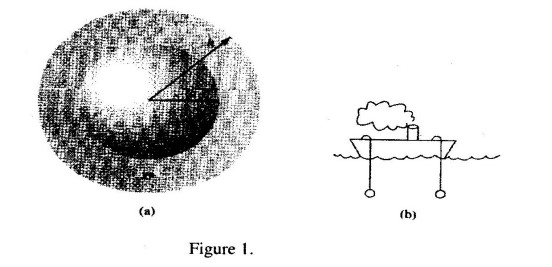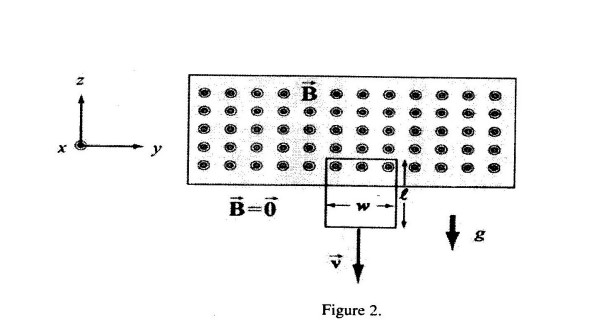PHY 102: Introduction to Physics-2
Tutorial-8
(Electromotive forces, Ohm’s law and Faraday’s law)
- Ohm's law:Two concentric metal spherical shells, of radius $a$ and $b$ (Fig.1), respective, are separated by weakly conducting material of conductivity $\sigma$.
- [(A)] If they are maintained at a potential difference $V$, what current flows from one to the other.
- [(B)] What is the resistance between the shells?
- [(C)] Notice that the outer radius $b$ is irrelevant, if $b>\gg a$.

- Faraday's law: A rectangular loop of wire with mass $m$ which $w$ vertical length $l$, and resistance $R$ falls out of a magnetic field under the influence of gravity, as shown in the Fig.2 below. The magnetic field is uniform and out of the paper $(\vec{\pmb B}=B\hat{i})$ within the area shown and zero outside of that area. At the time shown in the sketch, the loop is existing the magnetic field at speed $\vec{\pmb\nu}=-\nu\hat{k}$. (A) Find an expression for the magnitude of the $emf$ in this circuit in terms of the quantities given. What is the magnitude of the current flowing in the circuit at the time shown, (B) (Besides gravity, what other forces acts on the loop in the $\pm\hat{k}$ direction? Give its magnitude and direction in terms of the quantities given.
 (C) Assume that the loop has reached a ``terminal velocity'' and is no longer accelerating. What is the magnitude of that terminal velocity in terms of given quantities? (D) Show that at terminal velocity, the rate at which gravity is doing work on the loop is equal to the rate at which energy is being dissipated in the loop through Joule heating.
(C) Assume that the loop has reached a ``terminal velocity'' and is no longer accelerating. What is the magnitude of that terminal velocity in terms of given quantities? (D) Show that at terminal velocity, the rate at which gravity is doing work on the loop is equal to the rate at which energy is being dissipated in the loop through Joule heating. - Magnetic resonance imaging: Strong magnetic fields are used in medical procedures such as magnetic resonance imaging (MRI). A technician wearing a brass bracelet enclosing area 0.005 m$^2$ places her hand in a solenoid whose magnetic field is 5.00 T directed perpendicular to the plane of the bracelet. The electrical resistance around the circumference of the bracelet is 0.020 $\Omega$. An unexpected power failure causes the field to drop to 1.50 T in a time of 20.0 ms. Find (a) the current induced in the bracelet and (b) the power delivered to the bracelet. (Note: As this problem implies, you should not wear any metal objects when working in regions of strong magnetic fields. In addition, when in a MRI you should take care not to have any objects form a closed a loop with your body. From Faraday's Law, a current will be induced in the object and will pass through you. This can happen for example with an IV cord.)
Exclude node summary :
n
Exclude node links:
0
4727:Diamond Point
0






 ||Message]
||Message]
